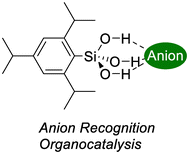Anion recognition by silanetriol in acetonitrile†
Abstract
The anion recognition ability of 2,4,6-triisopropylphenylsilanetriol 5 has been evaluated by 1H NMR titrations in MeCN-d3. The anion recognition ability of silanetriol 5 was greater than those of the structurally related silanediols and silanemono-ol, although less effective than those of 1,3-disiloxane-1,3-diol and 1,3-disiloxane-1,1,3,3-tetraol. From the comparison of the association constants and DFT calculations, all three silanol groups of 5 cooperatively hydrogen bonded to anionic species. The catalytic ability of silanetriol 5 for the addition of indole to β-nitrostyrene in CH2Cl2 has also been evaluated. Silanetriol 5 acts as a more effective organocatalyst than the corresponding silanediol in this reaction.



 Please wait while we load your content...
Please wait while we load your content...